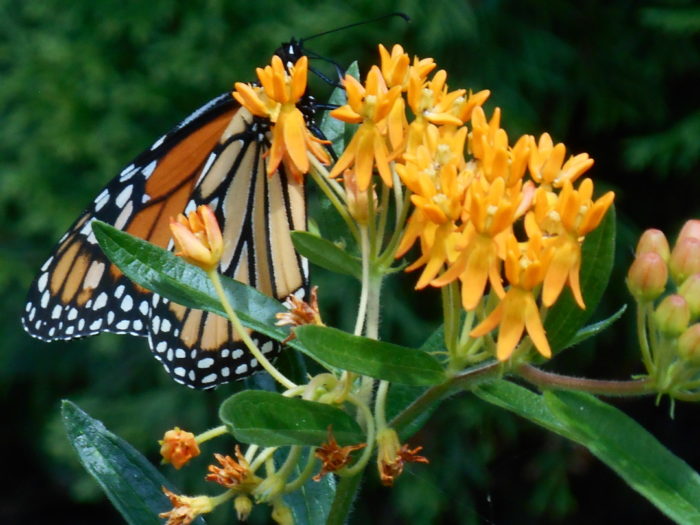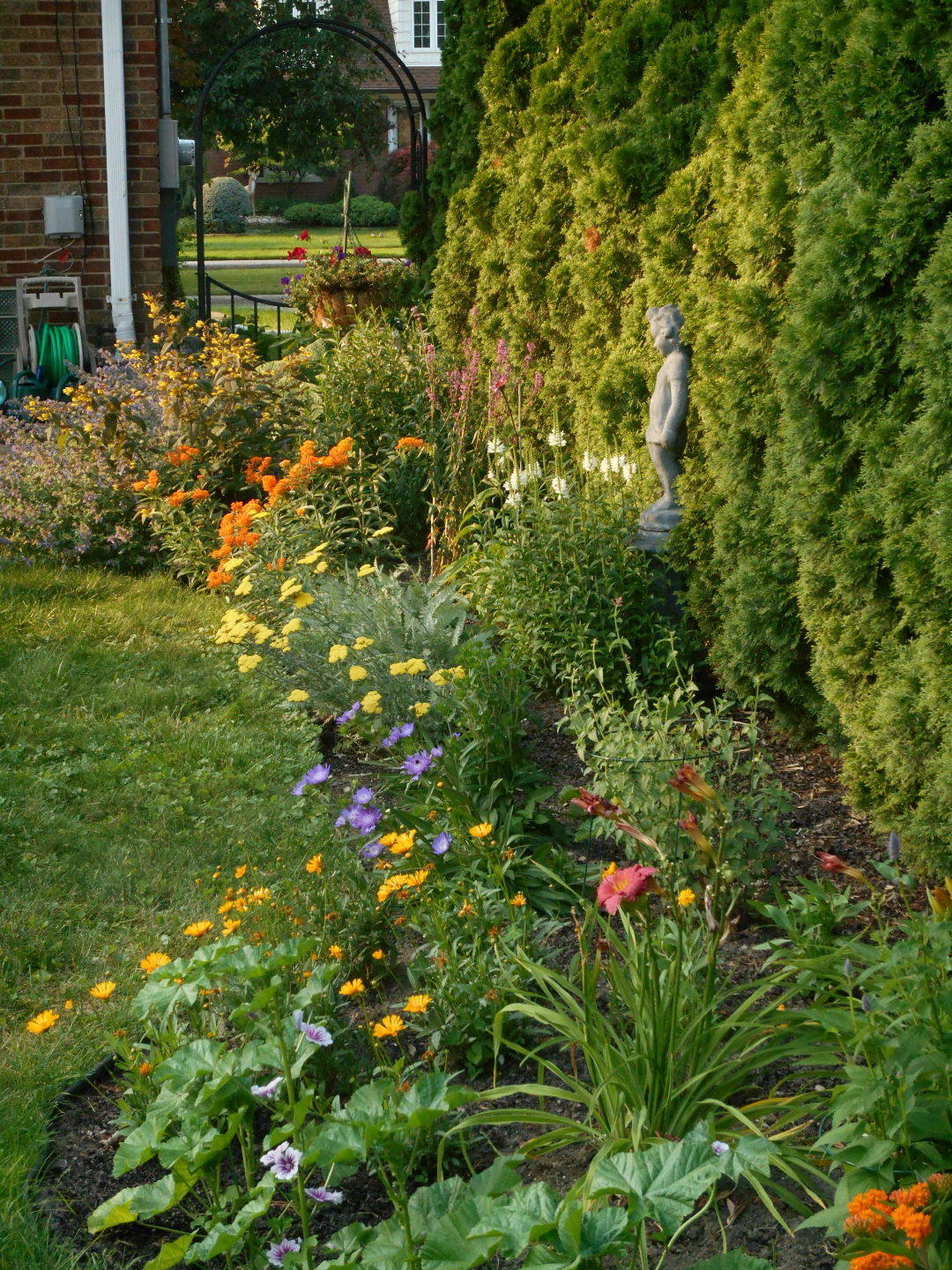
Today we’re visiting Lynn DeSantis’s garden, where she has a lot of flowers that attract the attention of humans and butterflies.
 Stokes aster (Stokesia laevis, Zones 5–9), obedient plant (Physostegia virginiana, Zones 3–9), and buddleia (Buddleia davidii, Zones 5–9) by the patio. This planting makes use of a very simple design technique: choose plants with flowers in a similar color range, and it really makes the garden look more cohesive and intentional.
Stokes aster (Stokesia laevis, Zones 5–9), obedient plant (Physostegia virginiana, Zones 3–9), and buddleia (Buddleia davidii, Zones 5–9) by the patio. This planting makes use of a very simple design technique: choose plants with flowers in a similar color range, and it really makes the garden look more cohesive and intentional.
 Another great combination of colors. Dark burgundy drumstick allium (Allium sphaerocephalon, Zones 4–8) combined with a soft lavender bellflower (possibly Campanula rapunculoides, Zones 3–9) and a purple bee balm (Monarda sp.) that echoes the color of the allium, but in a lighter shade that ties in the bellflower.
Another great combination of colors. Dark burgundy drumstick allium (Allium sphaerocephalon, Zones 4–8) combined with a soft lavender bellflower (possibly Campanula rapunculoides, Zones 3–9) and a purple bee balm (Monarda sp.) that echoes the color of the allium, but in a lighter shade that ties in the bellflower.
 The walkway leads through the gate to the patio and the garden beside it.
The walkway leads through the gate to the patio and the garden beside it.
 A black swallowtail butterfly feeding on a purple coneflower (Echinacea purpurea, Zones 3–8). This beautiful butterfly feeds on the nectar from a wide range of different flowers as an adult. If you want more of them in your garden, make sure to plant food for the caterpillars as well. They love many plants in the carrot family, including Queen Anne’s lace, carrots, celery, dill, fennel, and parsley.
A black swallowtail butterfly feeding on a purple coneflower (Echinacea purpurea, Zones 3–8). This beautiful butterfly feeds on the nectar from a wide range of different flowers as an adult. If you want more of them in your garden, make sure to plant food for the caterpillars as well. They love many plants in the carrot family, including Queen Anne’s lace, carrots, celery, dill, fennel, and parsley.
 A monarch feeding on the bright orange flowers of the butterfly weed (Asclepias tuberosa, Zones 3–9). Monarch caterpillars only feed on the leaves of plants in the milkweed genus, Asclepias. This plant is a beautiful one that pleases human and insect visitors alike.
A monarch feeding on the bright orange flowers of the butterfly weed (Asclepias tuberosa, Zones 3–9). Monarch caterpillars only feed on the leaves of plants in the milkweed genus, Asclepias. This plant is a beautiful one that pleases human and insect visitors alike.
 Swamp milkweed (Asclepias incarnata, Zones 3–8) is another beautiful milkweed that is great for gardeners as well as monarch butterflies. As the name implies, this species is a good choice if you have consistently wet soil, though it will thrive in normal, well-drained garden soil as well.
Swamp milkweed (Asclepias incarnata, Zones 3–8) is another beautiful milkweed that is great for gardeners as well as monarch butterflies. As the name implies, this species is a good choice if you have consistently wet soil, though it will thrive in normal, well-drained garden soil as well.
 A cloud of ‘Purple Sensation’ ornamental onions (Allium ‘Purple Sensation’, Zones 4–7).
A cloud of ‘Purple Sensation’ ornamental onions (Allium ‘Purple Sensation’, Zones 4–7).
 A final view of the garden.
A final view of the garden.
Have a garden you’d like to share?
Have photos to share? We’d love to see your garden, a particular collection of plants you love, or a wonderful garden you had the chance to visit!
To submit, send 5-10 photos to [email protected] along with some information about the plants in the pictures and where you took the photos. We’d love to hear where you are located, how long you’ve been gardening, successes you are proud of, failures you learned from, hopes for the future, favorite plants, or funny stories from your garden.
If you want to send photos in separate emails to the GPOD email box that is just fine.
Have a mobile phone? Tag your photos on Facebook, Instagram or Twitter with #FineGardening!
You don’t have to be a professional garden photographer – check out our garden photography tips!
Do you receive the GPOD by email yet? Sign up here.
Fine Gardening Recommended Products

Buffalo-Style Gardens: Create a Quirky, One-of-a-Kind Private Garden with Eye-Catching Designs
Fine Gardening receives a commission for items purchased through links on this site, including Amazon Associates and other affiliate advertising programs.

isYoung Birdlook® Smart Bird Feeder with Camera
Fine Gardening receives a commission for items purchased through links on this site, including Amazon Associates and other affiliate advertising programs.

National Wildlife Federation®: Attracting Birds, Butterflies, and Other Backyard Wildlife, Expanded Second Edition (Creative Homeowner) 17 Projects & Step-by-Step Instructions to Give Back to Nature
Fine Gardening receives a commission for items purchased through links on this site, including Amazon Associates and other affiliate advertising programs.


















Comments
Beautiful gardens. Thank you for sharing! Just wondering what zone you are in and these flowers are in bloom now?
So pretty, wonderful combinations. also wondering what zone, my sensation alliums bloom way before my Stokes aster, so pretty together.
I have always believed there is no point in gardening if you are not doing it for butterflies & bees. Love your monarch shots.
Morning coffee (yup, it's 10AM LOL!) and a tour of your well thought out garden. Just love the photo you titled "A Final View of the Garden" - to see the garden statue with the evergreens behind it and then the perennials border in front- you get privacy and a nice green background for the statue all year - and then the burst of blooms in your front border and easy to reach to tend to.. This is what I'm also attempting to do in my new garden. I'm also growing "Campanula rapunculoides aka Creeping Campanula" in spite of some online articles criticizing them for reasons I do not agree with. They are one of my favorite non-fussy, beautiful perennials, always welcomes in my garden. The butterflies and bees that are attracted to your garden are such a big part of what makes a garden so enjoyable. I just love what you have accomplished- very beautiful.
Really beautiful garden. Loved the combo in the side yard- bee balm, campanula & the alliums. Trying to figure out how to get those 3 to bloom at the same time in my garden...?. Right plant, right place. Loved it all !
I believe the soft lavender bellflower/campanula shown with the allium is an adenophora also called ladybells. Apparently it is a close relative of campanula. It spreads by runners and by seed. The malva 'zebrina' in the last photo also reseeds, but you do an excellent job of controlling the spreaders to create a lovely garden!
You are right they may be Ladybells, but the only way to tell them apart from the identical looking Creeping Campanula is to dissect the flower according to this link. http://www.coldclimategardening.com/2007/07/26/campanula-rapunculoides-the-evil-twin/
And another way to ID is supposedly Creeping Campanula "spread very well", and Ladybells are "well behaved" not spreading so much. I have both and they look just the same to me. The Ladybells are native and the Creeping Campanula have a European origin.
Log in or create an account to post a comment.
Sign up Log in